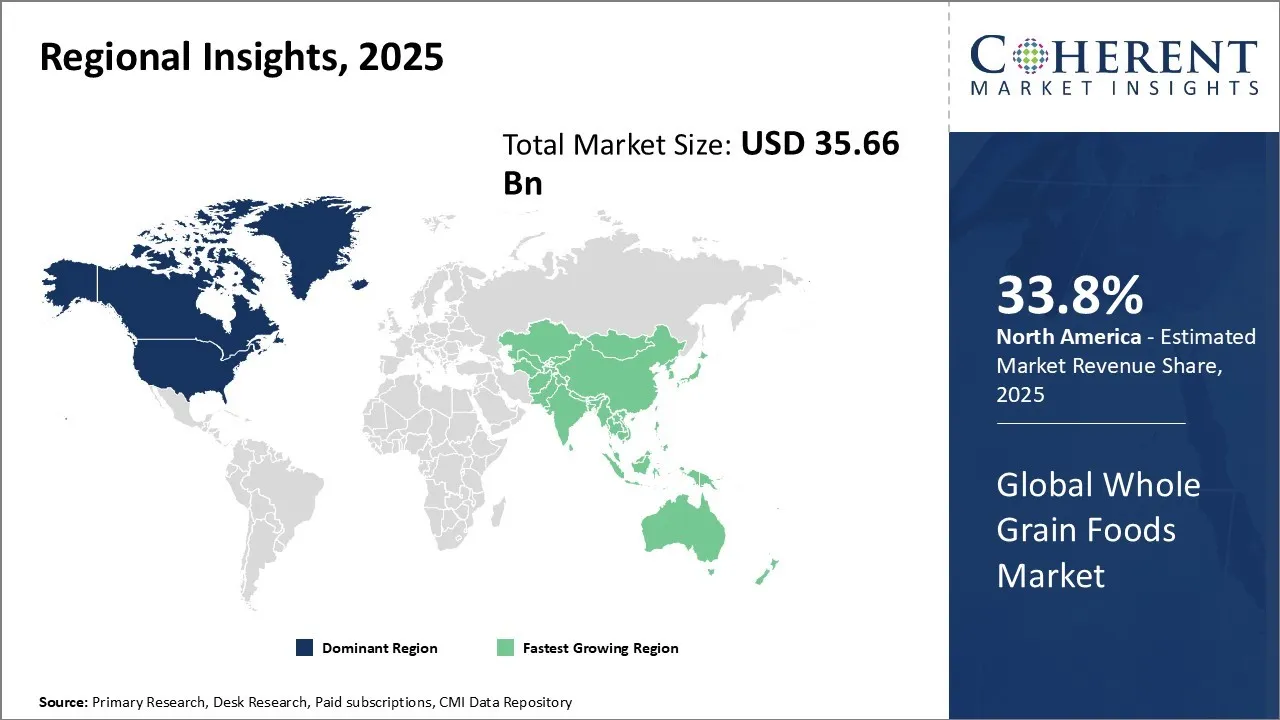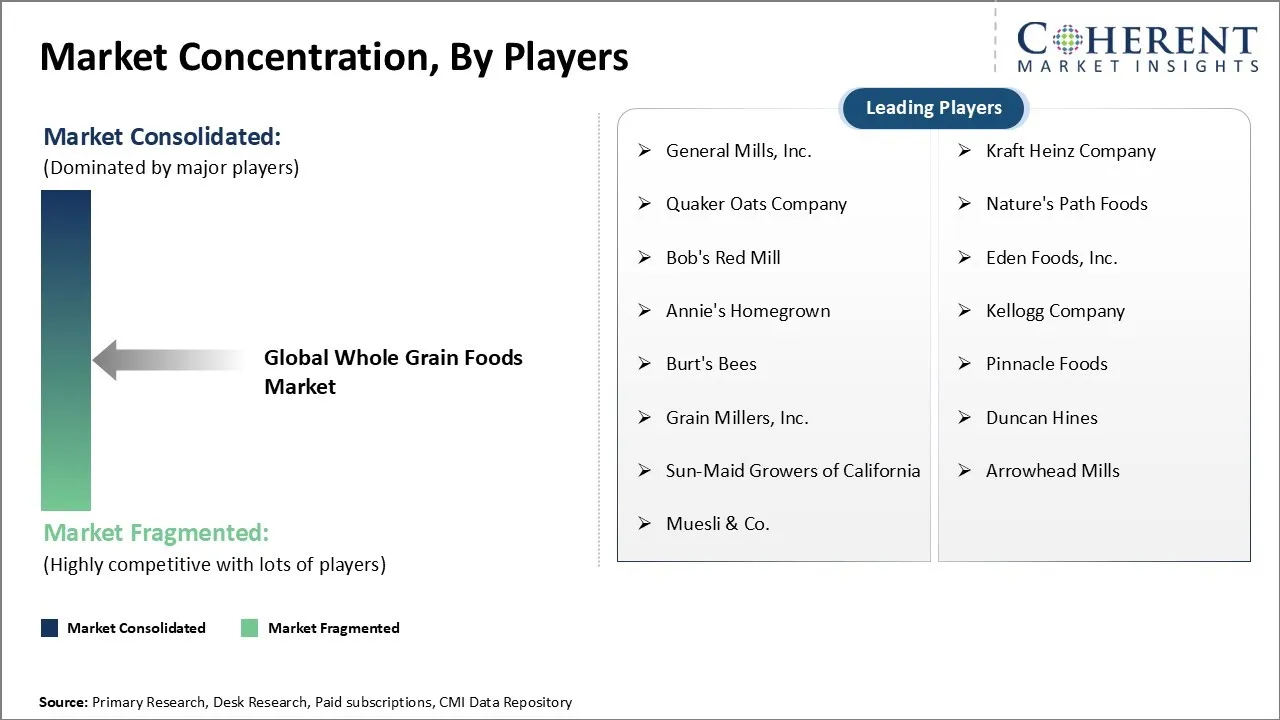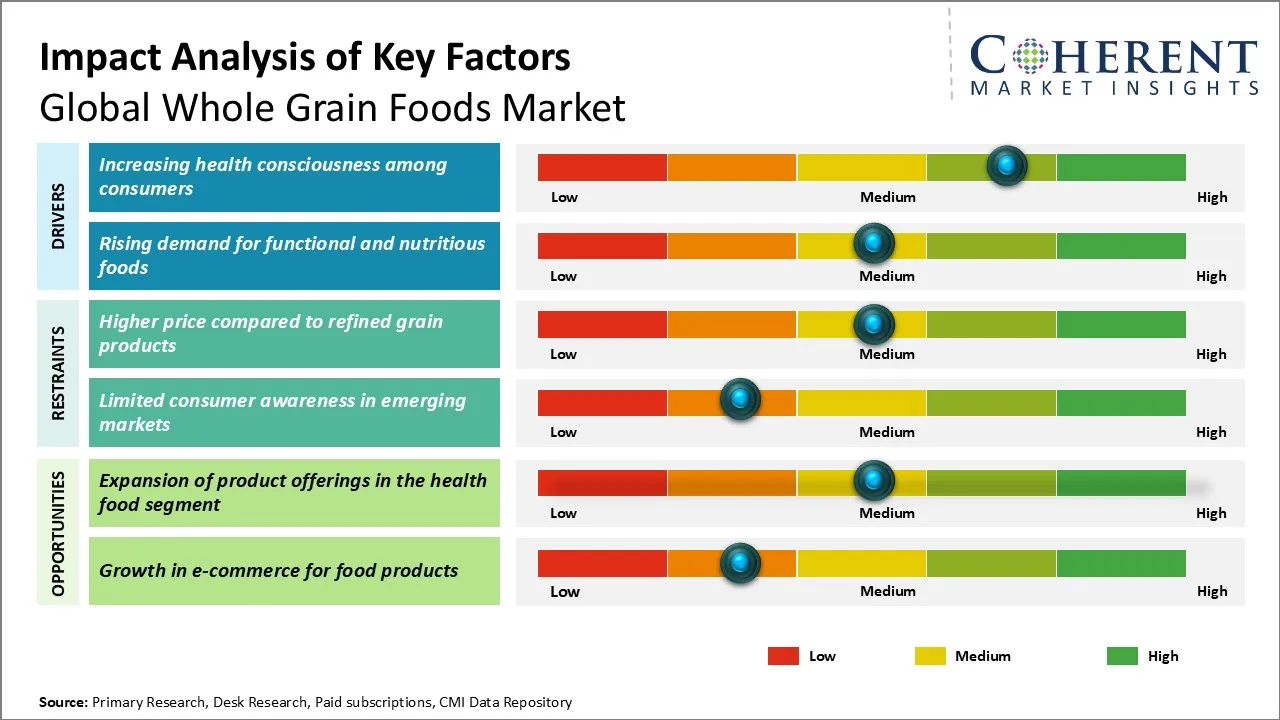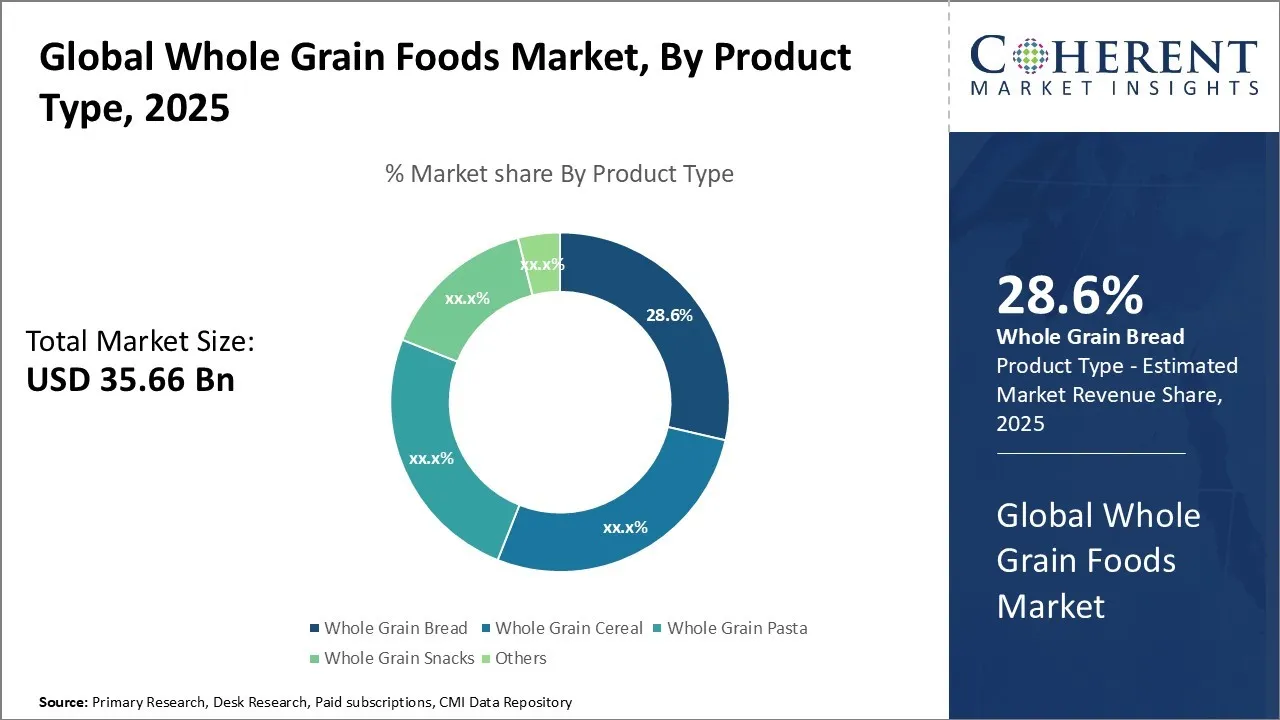Global Whole Grain Foods Market Size and Forecast
The Global Whole Grain Foods Market is estimated to be valued at USD 35.66 Bn in 2025 and is expected to reach USD 56.14 Bn by 2032, exhibiting a compound annual growth rate (CAGR) of 6.7% from 2025 to 2032.
Key Takeaways of the Whole Grain Foods Market
- Whole grain bread segment is expected to account for 28. 6% of the market share in 2025.
- The multi-grain segment is projected to hold a 29. 6% share of the global whole grain foods market in 2025.
- The cans segment is expected to account for 32. 7% of the global whole grain foods market in 2025.
- North America is set to lead the global whole grain foods market in 2025 with a 33. 8% share. Asia Pacific, with a 11.5% share, will be the fastest-growing region.
Market Overview
The trend towards healthier lifestyles and the growing demand for nutritious food options are driving the expansion of the whole grain foods market. Consumers are increasingly seeking out whole grain alternatives to refined grain products like corn grit. This has led to a surge in the development and marketing of innovative whole grain food items across various categories, including bakery products, cereal-based snacks, snacks, and pasta. Additionally, the rise of the gluten-free trend has further boosted the demand for whole grain gluten-free options, catering to the needs of consumers with gluten sensitivities or celiac disease.
Currents Events and their Impact
|
Current Events |
Description and its impact |
|
U.S. Tariff Changes and Global Trade Shifts |
|
|
Regulatory Updates: U.S. FDA Redefines “Healthy” Labeling |
|
Uncover macros and micros vetted on 75+ parameters: Get instant access to report
Whole Grain Foods Market Insights, By Product Type - Whole Grain Bread Segment Dominates the Market due to a Healthier Choice for Consumers
Whole grain bread segment is expected to contribute 28.6% share of the market in 2025, owing to the rising consumer awareness about the health benefits associated with whole grain consumption. Whole grain bread is a rich source of dietary fiber, vitamins, minerals, and antioxidants, which are essential for maintaining overall health and well-being. Women's Health Initiative Observational Study have shown that regular consumption of whole grain bread can reduce the risk of chronic diseases such as heart disease, diabetes, and certain types of cancer.
Whole Grain Foods Market Insights, By Source - Multi-Grain Segment Dominates due to a Nutritional Powerhouse
Multi-grain segment is expected to contribute 29.6% share of the global whole grain foods market in 2025. Multi-grain products are made from a combination of different whole grains, such as wheat, oats, barley, rye, and corn, which provide a diverse range of nutrients and health benefits.
One of the primary factors driving the growth of the multi-grain segment is the increasing consumer demand for nutrient-dense foods. Multi-grain products are rich in dietary fiber, protein, vitamins, minerals, and phytochemicals, which are essential for maintaining a healthy digestive system, promoting satiety, and reducing the risk of chronic diseases. Moreover, the combination of different grains in multi-grain products provides a more balanced nutritional profile compared to single-grain products.
Whole Grain Foods Market Insights, By Packaging Format - Cans Segment Dominates the Convenient and Shelf-Stable Packaging Solution for Whole Grain Foods
Cans segment is expected to contribute 32.7% share of the global whole grain foods market in 2025. The popularity of cans as a packaging solution for whole grain foods can be attributed to several factors, including convenience, shelf-stability, and product protection. One of the primary advantages of cans is their convenience for consumers.
Regional Insights

To learn more about this report, Download Free Sample
North America Whole Grain Foods Market Analysis and Trends
The North America region is projected to lead the market with a 33.8% share in 2025. The region has a well-established market ecosystem, with a strong presence of major food manufacturers and a growing consumer preference for healthier food options. Government policies and initiatives promoting healthy eating habits have further supported the growth of the whole grain foods market in North America.
For example, General Mills has been at the forefront of promoting whole grain consumption with its well-known brand Cheerios, which is marketed as a heart-healthy, whole grain product. Additionally, Kellogg’s has expanded its whole grain offerings, such as their All-Bran cereals and Special K products, emphasizing its health benefits. PepsiCo has also ventured into the whole grain market with its Quaker Oats brand, which offers a wide range of whole grain products including oatmeal and granola bars.
Asia Pacific Whole Grain Foods Market Analysis and Trends
The Asia Pacific region is expected to exhibit the fastest growth in the market contributing 11.5% share in 2025. This growth can be attributed to the rising disposable incomes, changing lifestyles, and increasing health consciousness among consumers in the region. Countries like China and India, with their large populations and growing middle class, have witnessed a surge in demand for whole grain foods. Government initiatives to address health concerns such as obesity and diabetes have also contributed to the market's growth. Local players like Nissin Foods and Marico have also made significant contributions to the market's growth by introducing innovative whole grain products tailored to regional preferences.
Global Whole Grain Foods Market Outlook for Key Countries
U.S. Whole Grain Foods Market Trends
The U.S. whole grain foods market continues to thrive, driven by a strong focus on health and wellness. Consumers are increasingly seeking out whole grain options, with a growing preference for ancient grains like quinoa and amaranth. Major players such as General Mills and Kellogg's have responded to this demand by expanding their whole grain product portfolios and investing in research and development. Government initiatives like the Dietary Guidelines for Americans, which recommend increasing whole grain intake, have further supported the market's growth.
China Whole Grain Foods Market Trends
China whole grain foods market is experiencing rapid growth, fueled by rising health awareness and changing dietary habits. The country's large population and increasing disposable incomes have created a significant demand for healthier food options. The Chinese government's focus on promoting a healthy lifestyle has also contributed to the market's expansion. Key players like Nestle and PepsiCo have recognized the potential of the China whole grain foods market and have introduced localized whole grain products to cater to regional tastes and preferences.
India Whole Grain Foods Market Trends
India continues to be a promising market for whole grain foods, with a growing middle class and increasing health consciousness. Traditional staples like wheat and rice are being replaced by healthier whole grain alternatives. The government's initiatives to address malnutrition and promote healthy eating habits have further supported the market's growth. Local players like Britannia Industries and ITC Limited have capitalized on this trend by introducing a range of whole grain products, including biscuits, bread, and snacks.
Germany Whole Grain Foods Market Trends
Germany whole grain foods market is driven by a strong emphasis on health and sustainability. Consumers are increasingly opting for whole grain products as part of a balanced diet. The country's strict food regulations and labeling requirements have also contributed to the market's growth by ensuring transparency and quality. Key players like Dr. Oetker and Mestemacher have played a significant role in promoting whole grain consumption through their innovative product offerings and marketing campaigns.
Japan Whole Grain Foods Market Trends
Japan whole grain foods market is characterized by a growing interest in functional and health-promoting ingredients. Consumers are seeking out whole grain options to address health concerns such as digestive issues and weight management. The country's aging population and increasing health consciousness have further fueled the demand for whole grain foods. Major players like Nissin Foods and Ezaki Glico have responded to this trend by developing whole grain products that align with Japanese dietary preferences and culinary traditions.
End User Feedback and Unmet Needs
Positive User Experience and Satisfaction
A notable example of positive feedback comes from health-conscious consumers in the nutritional food sector who have expressed high satisfaction with the nutrient density and digestive benefits offered by whole grain foods. Many end-users appreciate the enhanced fiber content in products like whole grain breads, cereals, and snacks, as it contributes to improved digestion and helps in weight management. Consumers particularly value the nutritional transparency provided by manufacturers, with clear labeling of whole grain content on packaging, which aligns with growing consumer demand for healthier food options.
Technological Gaps in Processing and Packaging
There is an opportunity for manufacturers to invest in technologies that enhance the processing of whole grains to retain their nutritional benefits while ensuring consistency in texture, taste, and shelf-life. Current technology may not fully address consumer demands for high-quality, minimally processed foods, which could impact the appeal of whole grain foods.
Market Players, Key Development, and Competitive Intelligence

To learn more about this report, Download Free Sample
Key Developments
- In October 2024, the European Food Information Council (EUFIC) announced the launch of its Switch to Whole Grains campaign, supported by the Whole Grain Initiative. The campaign, set to run throughout November in 2024, aims to raise awareness about the health benefits of whole grains, which offer up to 75% more nutrients compared to refined grains. Despite these benefits, Europeans are not meeting the recommended daily intake of whole grains, contributing to an increased risk of chronic diseases such as heart disease, type 2 diabetes, and certain cancers. The science-backed initiative encourages consumers to incorporate whole grains into their daily diet for better long-term health.
Top Strategies Followed by Global Whole Grain Foods Market Players
- Established players in the global whole grain foods market are investing heavily in research and development to innovate high-performance products. These companies recognize the importance of staying ahead of the curve in terms of product quality, nutritional value, and consumer appeal. By dedicating significant resources to R&D, they aim to create whole grain food products that meet the evolving needs and preferences of health-conscious consumers.
- For example, General Mills' innovation with its Nature Valley brand has expanded to offer whole grain snacks that not only meet consumer demand for healthier choices but also address growing concerns over sustainability in food production. These companies understand the need to stay ahead in terms of product quality and nutritional value.
- Mid-level players in the market are focusing on delivering cost-effective solutions to target price-sensitive consumers. By offering quality whole grain food products at affordable prices, these companies aim to capture a significant portion of the market that values both nutrition and affordability. Furthermore, mid-level players are exploring collaborations with other companies to boost their technology, production capabilities, and market presence.
- For example, Bob's Red Mill offers affordable whole grain options like oatmeal and flour while maintaining high nutritional value. These companies are not only innovating to enhance product offerings but also focusing on affordability to capture a larger share of the health-conscious but budget-aware market segment.
- Small-scale players in the global whole grain foods market are adopting niche specialization strategies to differentiate themselves from larger competitors. By targeting specific niche markets with unique features or innovative products, these players can carve out a profitable segment of the market. Additionally, small-scale players are leveraging cutting-edge technologies to remain competitive in terms of product quality and efficiency.
- For instance, The Food Movement offers a line of organic whole grain products with a focus on local sourcing, ensuring high-quality ingredients and environmentally friendly practices. These companies target specific market segments by providing unique features or innovative products, catering to consumers who prefer artisanal or specialized food options.
Market Report Scope
Whole Grain Foods Market Report Coverage
| Report Coverage | Details | ||
|---|---|---|---|
| Base Year: | 2024 | Market Size in 2025: | USD 35.66 Bn |
| Historical Data for: | 2020 To 2024 | Forecast Period: | 2025 To 2032 |
| Forecast Period 2025 to 2032 CAGR: | 6.7% | 2032 Value Projection: | USD 56.14 Bn |
| Geographies covered: |
|
||
| Segments covered: |
|
||
| Companies covered: |
General Mills, Inc., Kraft Heinz Company, Quaker Oats Company, Nature's Path Foods, Bob's Red Mill, Eden Foods, Inc., Annie's Homegrown, Kellogg Company, Burt's Bees, Pinnacle Foods, Grain Millers, Inc., Duncan Hines, Sun-Maid Growers of California, Arrowhead Mills, and Muesli & Co. |
||
| Growth Drivers: |
|
||
| Restraints & Challenges: |
|
||
Uncover macros and micros vetted on 75+ parameters: Get instant access to report
Market Dynamics

To learn more about this report, Download Free Sample
Whole Grain Foods Market Driver - Increasing Health Consciousness Among Consumers
The global whole grain foods market is experiencing a significant driver in the form of increasing health consciousness among consumers worldwide. As people become more aware of the importance of maintaining a balanced diet and adopting healthier lifestyles, the demand for nutritious food options, including whole grain products, is on the rise. Consumers are actively seeking out foods that offer a range of health benefits, such as improved digestion, better heart health, and enhanced weight management. Whole grain foods, which are rich in essential nutrients, dietary fiber, and complex carbohydrates, have gained popularity as a key component of a healthy diet.
According to the World Health Organization (WHO), a diet rich in whole grains can help reduce the risk of cardiovascular diseases, type 2 diabetes, and colorectal cancer. In fact, the WHO recommends that adults consume at least 25 grams of dietary fiber per day, which can be easily achieved by incorporating whole grain foods into their diets.
Whole Grain Foods Market Opportunity - Expansion of Product Offerings in the Health Food Segment
The growing consumer interest in health and wellness presents a significant opportunity for the global whole grain foods market to expand its product offerings within the health food segment. As consumers become increasingly aware of the nutritional benefits of whole grains, such as their high fiber content, essential minerals, and potential to reduce the risk of chronic diseases, there is a rising demand for a wider variety of whole grain food options. Manufacturers can capitalize on this trend by developing innovative whole grain products that cater to diverse taste preferences, dietary requirements, and convenience needs.
According to the World Health Organization (WHO), a balanced diet rich in whole grains can help reduce the risk of heart disease, diabetes, and certain cancers. In fact, the WHO recommends that adults consume at least 400 grams of fruits and vegetables per day, including whole grains, to maintain optimal health. Additionally, the United Nations has declared 2023 as the International Year of Millets, recognizing the nutritional value and sustainability of these ancient whole grains.
Analyst Opinion (Expert Opinion)
- The whole grain foods market is experiencing dynamic growth, fueled by increasing consumer awareness of health and wellness benefits associated with whole grains. Brands like Bob's Red Mill and Nature's Path are leading the charge with innovative products that cater to the demand for nutritious, convenient options.
- Recent conferences, such as the Whole Grains Summit (2022) and the Food Ingredients Europe (2023), have highlighted the importance of whole grains in balanced diets, showcasing new research on their health benefits, including improved digestion and reduced chronic disease risk. These events also emphasize the need for clearer labeling and education to help consumers make informed choices. As more people seek healthier dietary options, the whole grain foods market is poised for substantial growth, driven by product innovation and a collective shift towards healthier eating habits.
Market Segmentation
- Product Type Insights (Revenue, USD Bn, 2020 - 2032)
- Whole Grain Bread
- Whole Grain Cereal
- Whole Grain Pasta
- Whole Grain Snacks
- Others
- Source Insights (Revenue, USD Bn, 2020 - 2032)
- Multi-Grain
- Rye
- Maize
- Quinoa
- Wheat
- Others
- Packaging Format Insights (Revenue, USD Bn, 2020 - 2032)
- Cans
- Bags and Pouches
- Trays and Containers
- Folding Cartons
- Distribution Channel Insights (Revenue, USD Bn, 2020 - 2032)
- Online Retail
- Supermarkets/Hypermarkets
- Convenience Stores
- Health Food Stores
- Regional Insights (Revenue, USD Bn, 2020 - 2032)
- North America
- U.S.
- Canada
- Latin America
- Brazil
- Argentina
- Mexico
- Rest of Latin America
- Europe
- Germany
- U.K.
- Spain
- France
- Italy
- Russia
- Rest of Europe
- Asia Pacific
- China
- India
- Japan
- Australia
- South Korea
- ASEAN
- Rest of Asia Pacific
- Middle East
- GCC Countries
- Israel
- Rest of Middle East
- Africa
- South Africa
- North Africa
- Central Africa
- North America
- Key Players Insights
- General Mills, Inc.
- Kraft Heinz Company
- Quaker Oats Company
- Nature's Path Foods
- Bob's Red Mill
- Eden Foods, Inc.
- Annie's Homegrown
- Kellogg Company
- Burt's Bees
- Pinnacle Foods
- Grain Millers, Inc.
- Duncan Hines
- Sun-Maid Growers of California
- Arrowhead Mills
- Muesli & Co.
Sources
Primary Research Interviews
- Director of R&D – Leading Whole Grain Foods Manufacturer
- Procurement Manager – Premium Whole Grain Foods Retailer
- Product Development Head – Major Food Manufacturer Specializing in Whole Grain Products
- Sustainability Manager – Whole Grain Certification Body
Stakeholders
- Manufacturers
- End-use Sectors
- Whole Grains (Cereals, Snacks, Baked Goods)
- Health-conscious Consumers (e.g., Gluten-Free, Organic Markets)
- Health Food Brands Focusing on Nutritional Benefits
- Regulatory & Certification Bodies
- E-commerce Platforms and Grocery Retailers
- Technology Integration Players: AI and machine learning providers for personalized skincare solutions
Databases
- FAO (Food and Agriculture Organization) Database – Global agricultural production and trends
- USDA Economic Research Service Database – Whole grain commodity production and consumption trends
Magazines
- Whole Grains Council Magazine – Industry trends, health benefits, and product innovations
- Food Technology Magazine – Advances in whole grain processing technologies
- Nutrition Business Journal – Growth of health food markets, including whole grain adoption
- Organic & Natural Products Magazine – Focus on organic whole grain foods
- Bakery & Snacks – Insights into whole grain bakery products and market dynamics
Journals
- Journal of Cereal Science – Research on whole grain chemistry, processing, and nutrition
- Food Research International – Studies on the nutritional impact of whole grains
- Journal of Agricultural and Food Chemistry – Whole grain antioxidants and health benefits
- Journal of Food Science – Food quality, sensory analysis, and consumer acceptance of whole grains
Newspapers
- The Guardian – Coverage on trends in healthy eating and the rise of whole grains in diets
- Financial Times – Market analysis of the food industry, with a focus on health trends
- Food Business News – Focus on the expanding whole grain market and innovation
- Global Food News – Emerging trends and consumer interest in whole grains
- The New York Times – Health reports and growing consumer preference for whole grain products
Associations
- Whole Grains Council – Advocacy for whole grain consumption and certification
- National Grain and Feed Association – Insights on grain trade and agricultural markets
- Food and Agriculture Organization (FAO) – Policy and market trends in whole grain production
- International Food Information Council (IFIC) – Research on food and health trends, including whole grains
- Grain Millers Association – Advocacy and market information for grain millers
- American Heart Association – Whole grains in the context of heart health and disease prevention
Public Domain Sources
- USDA – Food and Nutrition Service – Guidelines for healthy eating and whole grains
- EU Commission – Regulation of whole grain content in food products
- FAO – Global Food Production and Consumption Data – Agricultural trends and grain consumption globally
- World Health Organization (WHO) – Recommendations on dietary intake of whole grains for health benefits
Proprietary Elements
- CMI Data Analytics Tool, Proprietary CMI Existing Repository of information for last 8 years.
Share
Share
About Author
Sakshi Suryawanshi is a Research Consultant with 6 years of extensive experience in market research and consulting. She is proficient in market estimation, competitive analysis, and patent analysis. Sakshi excels in identifying market trends and evaluating competitive landscapes to provide actionable insights that drive strategic decision-making. Her expertise helps businesses navigate complex market dynamics and achieve their objectives effectively.
Missing comfort of reading report in your local language? Find your preferred language :
Transform your Strategy with Exclusive Trending Reports :
Frequently Asked Questions
EXISTING CLIENTELE
Joining thousands of companies around the world committed to making the Excellent Business Solutions.
View All Our Clients


